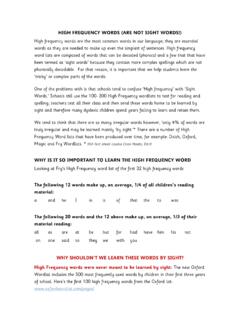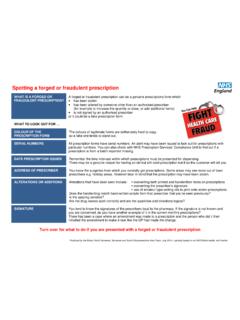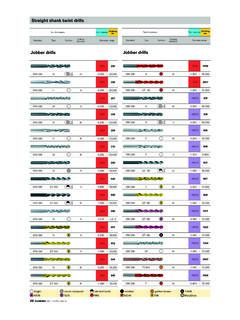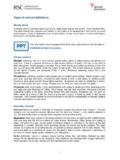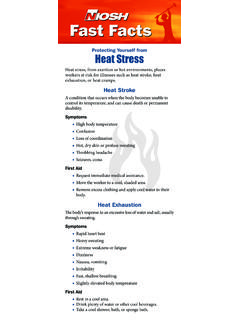Transcription of Spotting the Symptoms of Specific Learning …
1 Spotting the Symptoms of Specific Learning Difficulties in Class Including children with special needs can present major challenges to main stream schools. Senior school staff and teachers have to decide how to provide for the diverse and complex needs of all children in their classes. Additional information is being discovered all the time about different types of special needs and the remediation required. Of course this information is welcomed and helpful, however a class teacher has up to 30 individual children s needs to meet and wants to enable every child to meet their potential and has only 24 hours in a day! The whole process of formal diagnosis can be lengthy and sometimes a whole year can be wasted waiting for an assessment. Schools have found it beneficial to use the information provided below, about certain disorders and difficulties, to create checklists.
2 These checklists can be used when a teacher is concerned about a pupil to help them ascertain what the problems might be and provide support whilst waiting for a more formal diagnosis, if this is felt to be necessary and beneficial. Checklists Schools I have worked with have used the signs and Symptoms I have provided and put checklist boxes by the side of each one. As soon as the class teacher becomes concerned about a child she/he can record (or tick) Specific behaviours on the checklist. Very soon it should become apparent where there are clusters of ticks as to what the possible Learning difficulty might be. The school can then make parents aware of their concerns and also can begin to provide appropriate support Spotting the Symptoms of Specific Disorders in Class Symptoms of Dyslexia Dyslexia is the commonest cause of Learning difficulties for children and young people in schools and colleges.
3 The word comes from the Greek meaning 'difficulty with words.' The main Symptoms include difficulty with writing and spelling, and often with reading and working with numbers. A dyslexic person may also have problems putting things in order, following instructions, and may confuse left and right. The most common characteristic is that people have difficulty reading and spelling for no apparent reason. The person may be intelligent, able to achieve well in other areas and exposed to the same education as others, but is unable to read at the expected level. Despite intensive research, the exact causes of dyslexia still remain unknown but it is thought to often be inherited as it usually runs in families. Dyslexia can also be acquired through early hearing loss such as 'glue ear'. Symptoms of Dyslexia The following are Symptoms of dyslexia. A person does not have to have all Symptoms to be dyslexic and likewise a person having one or two of these Symptoms isn t necessarily dyslexic.
4 I have ordered the Symptoms into ages to help you, however Symptoms of 7 year olds may also be Symptoms encountered by adults with dyslexia. Pre-school Delayed speech not saying any words by the time they are one and not really talking until they are two and a half or older. Problems with pronunciation and mixing up sounds in multi- syllabic words such as aminal for animal, mazageen for magazine. Problems with rhyming words (this is one of the biggest indicators) and Learning rhymes. Difficulty with Learning shapes, colours and how to write their own name. Difficulty with retelling a story in the right order of events. Lots of ear or throat infections Forgets names of common words or people Finds it difficult to throw, catch or kick a ball. Primary School Reads below their expected level. Doesn t like reading books. Tries to avoid reading aloud in class.
5 When reading aloud reads very slowly and often ignores punctuation. Often has difficulty separating sounds in words and blending sounds to make words. Can read a word on one page but doesn t recognise it on the next. When they misread a word it will often be one that looks visually similar, with the same letters such as form and from or change the sequence of letters in a word such as who for how Problems with reading a single word in isolation, where there are no picture clues or storyline to assist. When reading will often lose their place on a line or skip lines When reading a sentence or a story will often substitute word that make sense but doesn t look at all similar, for example car for bus or ship for boat Often misreads or omits small words, for example: and, the, as, of, from. Spelling ability is normally far worse than their reading ability.
6 Spelling attempts can be bizarre. Regularly confuses certain letters when writing, such as d and b or u and n which is a classic symptom and relates to the whole problem that many dyslexics have with left and right. When writing b or d they will often use an upper case B or D Regularly writes words backwards, such as writing pot instead of top. Or transpose, for example left for felt Problems with grammar, such as Learning prefixes or suffixes. Can learn words for spelling tests at school and achieve 10 out of 10. But a day later they misspell the same words in their free writing. Find copying from the board very difficult and will frequently lose their place and misspell words. Work is often very messy with many crossings out Has poor pencil grip with a tendency to grab the pencil. Writes slowly and handwriting poor Forms letters from the wrong place and often has trouble making the letters sit on the line There is usually a vast difference between a child s verbal ability and the quality of their written work.
7 Most of the writing lacks even the basic forms of punctuation. They normally can t self-correct their work when proof-reading. Has trouble Learning colours, days of the week, months of the year and how to write his/her name, their birth date Has problems with sequences like multiplication tables, today/tomorrow Have trouble retaining facts Has extreme difficulty in telling the time. They may manage o clock and half past but anything else becomes too difficult for them. They will write some numbers backwards, for example 41 for 14. Poor concentration Unable to follow multi-step directions or routines. For example if you ask them to go upstairs, get undressed, have a wash and bring down a book, they will probably forget one of your directions (and not necessarily to wash!). Most dyslexics have significant problems in directionality, telling left from right Spotting the Symptoms of Specific Disorders in Class Autism Spectrum Disorder Autism is a spectrum disorder, meaning that there is a wide degree of variation in the way it affects people.
8 Every child on the autism spectrum has unique abilities, Symptoms , and challenges. Children with autism spectrum disorders usually have particular communication and social characteristics in common, but the conditions cover a wide spectrum, with individual differences in: severity, age it starts, how many Symptoms they show and how well the child can function Every individual on the autistic spectrum has problems to some degree with social skills, empathy, communication, and the ability to be flexible. But the level of disability and the combination of Symptoms can vary significantly from child to child. The 3 most common categories of Autistic spectrum disorder are: Autism (the most severe of the three) Asperger's Syndrome (high functioning autism is the mildest of the 3) Pervasive Developmental Disorder As the 3 autism spectrum disorders share many similar Symptoms , it can be difficult to distinguish one from the other, particularly in the early stages.
9 By the time a child reaches school autism spectrum disorder will normally have been diagnosed, but not always. Autism and Asperger's- Symptoms On the next pages are listed the signs and Symptoms of Autism and Asperger's Spotting the Symptoms of Specific Disorders in Class Symptoms of Autism Autism is a complex brain disorder that affects many aspects of child development, including how a child talks, plays, and interacts. Early intervention makes a huge difference in the outcome of the disorder, so as a teacher, it's important to know the Symptoms of autism and seek advice if you have concerns about a particular child. Autism occurs with equal frequency across all races, ethnicities, and social classes. However, boys are three to four times more likely to have autism than girls and the siblings of those with the disorder are also at a higher risk. The Symptoms of autism vary widely, as does the severity of the disorder.
10 There are 3 main areas that will be affected: Social Skills impaired social interaction is the hallmark sign of autism and one that most people are aware of and associate with autism. Children with autism often appear to be in their own little world. They may have some or a significant inability to make eye contact. They often appear totally uninterested in other people and their surrounding environment. They have trouble engaging in co-operative play with peers, making friends, and understanding what others are thinking and feeling. Communication Autism also involves problems with verbal and nonverbal communication. Spoken language is usually delayed in autistic children and may even be completely absent. Children with autism usually have trouble conversing freely and easily. Other common Symptoms involve odd or repetitive speech patterns, inappropriate facial expressions and gestures, and language comprehension difficulties.
